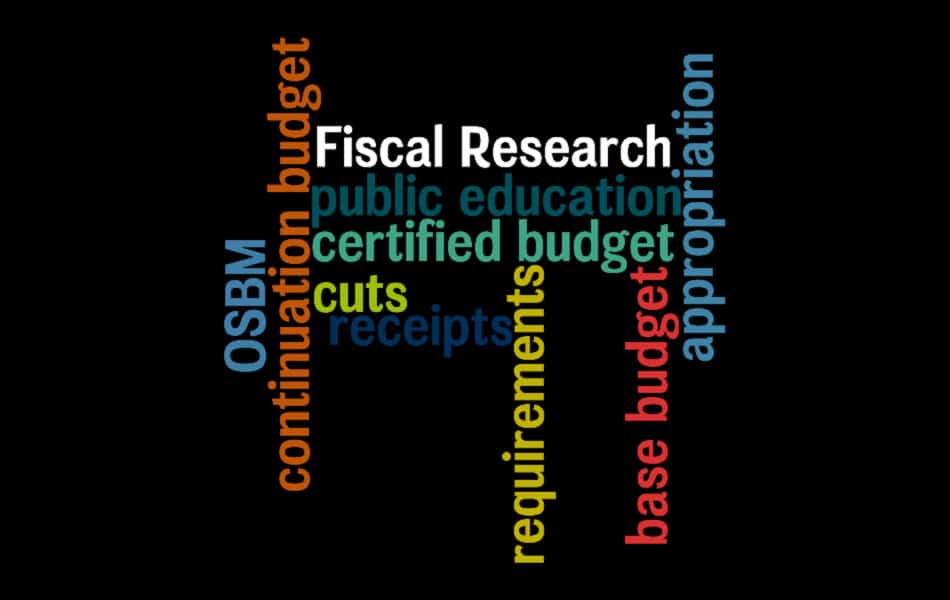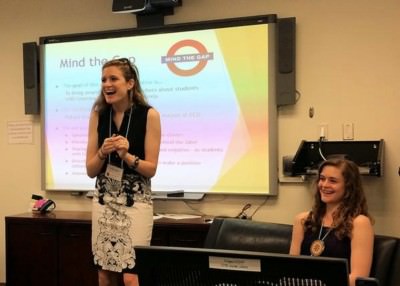
Between the campaign ads last fall and the negative headlines that dominate coverage of our schools, it is hard to know what the deal is with education funding. Is it up? Is it down? Both sides rely on numbers that support their conclusions and pick the comparison point that strengthens their argument. The debate around budget cuts — what exactly has been cut and by how much — is also confusing.
As we prepare to consider the Governor’s budget for 2015-17, here is some information about the 2014-15 budget, which revised the state’s 2013-15 budget. Funding and spending can be different; this article is about funding.
One of the easiest ways for the public to track state funding over time is to use the revised appropriation year to year. Each session there is a budget bill, and there is also a companion joint conference committee report, which provides details on the increases and decreases to the budget. Both are available back to 2005 on the legislature’s website in the Fiscal Research Division under budget legislation.
In the committee report, there is a summary of general fund appropriations (click image to enlarge):

When you hear budget numbers, the first question is what does the number include? Is it a total number for public education, community colleges, and the university system? Or just public education?
In EdNC’s EdLibrary, we have excerpted the summary of general fund appropriations from the committee report from 2005-2015.
Revised Appropriation for Public Education (K-12), 2005-15
|
2005-06 |
$6,607,998,945 |
|
2006-07 |
6,719,751,118 |
|
2007-08 |
7,714,429,569 |
|
2008-09 |
7,802,046,538 |
|
2009-10 |
7,456,261,240 |
|
2010-11 |
7,085,588,912 |
|
2011-12 |
7,464,492,057 |
|
2012-13 |
7,506,553,067 |
|
2013-14 |
7,867,960,649 |
|
2014-15 |
$8,104,976,608 |
Note that legislation passed after the budget bill — often technical corrections bills, but sometimes other bills — can change the budget numbers. The difficulty involved in tracking down those modifications sometimes adds to the confusion surrounding final budget numbers.
The Office of State Budget and Management (OSBM) certifies the budget after the session adjourns. In 2014-15, the certified budget for education is 956 pages long. Don’t worry — you can find what you need to know in the first six pages, which is a summary by purpose. This year, the certified budget matches up with the budget bill — $8,104,976,608 for the state appropriation.
According to the certified budget, total funding for public education is $11,513,577,425. Funding from other sources accounts for the extra $3,408,600,817. This chart shows how the money is spent:
2014-15 Certified Budget
DPI = Department of Public Instruction, LEA = Local Education Agency
RttT = Race to the Top
SPSF = State Public School Fund
Source: OSBM Certified Budget, EdNC calculated the 2014-15 State Appropriation
| Fund Code | Fund Title | 2014-15 Requirements | 2014-15 Receipts | 2014-15 State Appropriation |
|---|---|---|---|---|
| 1000 | DPI – Executive and Administrative Functions | $8,369,635 | $4,240,240 | $4,129,395 |
| 1021 | DPI – Education Innovations – 21st Century Schools | $1,317,886 | $58,475 | $1,259,411 |
| 1080 | RttT – Management | $1,301,663 | $1,301,663 | $0 |
| 1081 | RttT – Technical Infrastructure | $14,095,145 | $14,095,145 | $0 |
| 1082 | RttT – Evaluation | $2,750,779 | $2,750,779 | $0 |
| 1083 | RttT – Instructional Improvement | $6,803,297 | $6,803,297 | $0 |
| 1084 | RttT – Teacher and Principal Evaluation | $1,205,025 | $1,205,025 | $0 |
| 1086 | RttT – Leadership Academy | $7,958,842 | $7,958,842 | $0 |
| 1087 | RttT – Teach for America | $2,498,500 | $2,498,500 | $0 |
| 1088 | RttT – NC Teacher Corps | $1,957,299 | $1,957,299 | $0 |
| 1089 | RttT – Induction Support | $2,062,127 | $2,062,127 | $0 |
| 1091 | RttT – Virtual Courses | $1,822,485 | $1,822,485 | $0 |
| 1092 | RttT – Professional Development | $9,615,414 | $9,615,414 | $0 |
| 1093 | RttT – Turning Around | $10,346,881 | $10,346,881 | $0 |
| 1094 | RttT – STEM Anchor Schools | $1,015,790 | $1,015,790 | $0 |
| 1100 | Assistance to Districts and Schools – DPI | $21,987,416 | $16,692,182 | $5,295,234 |
| 1300 | DPI – Financial and Business Services | $3,136,154 | $816,827 | $2,319,327 |
| 1330 | DPI – Student and School Support Services | $15,361,116 | $11,650,421 | $3,710,695 |
| 1400 | Office of Early Learning | $73,449,823 | $65,579,940 | $7,869,883 |
| 1410 | North Carolina Center for the Advancement of Teaching | $3,219,422 | $200 | $3,219,222 |
| 1440 | Family Engagement | $750,000 | $750,000 | $0 |
| 1450 | K-3 Assessment | $2,748,986 | $2,748,986 | $0 |
| 1500 | DPI – Technology Services | $11,845,287 | $4,372,339 | $7,472,948 |
| 1600 | DPI – Curriculum, Instruction, Accountability and Technology | $56,482,982 | $45,364,166 | $11,118,816 |
| 1640 | Educator Quality and Recruitment – DPI | $18,872,074 | $18,116,316 | $755,758 |
| 1660 | DPI – Special Populations | $43,707,328 | $39,675,306 | $4,032,022 |
| 1800 | K-12 Classroom Instruction -SPSF | $6,837,109,503 | $630,409,717 | $6,206,699,786 |
| 1808 | SPSF – Statewide System Operations and Maintenance | $10,258,861 | $0 | $10,258,861 |
| 1810 | SPSF – Local Education Agency – Administraton | $92,511,468 | $0 | $92,511,468 |
| 1811 | Assistance to Districts and Schools – SPSF | $1,255,840,228 | $1,255,840,228 | $0 |
| 1821 | SPSF – Education Innovations – 21st Century Schools | $30,258,507 | $0 | $30,258,507 |
| 1830 | SPSF – Student and School Support Services | $653,082,643 | $144,927,281 | $508,155,362 |
| 1840 | SPSF – Teacher Quality and Recruitment | $365,832,301 | $365,832,301 | $0 |
| 1860 | SPSF – Special Populations | $1,582,827,875 | $684,277,137 | $898,550,738 |
| 1861 | Residential School – Administration | $266,754 | $0 | $266,754 |
| 1862 | NC School for the Deaf | $7,973,922 | $7,500 | $7,966,422 |
| 1863 | Eastern NC School for the Deaf | $7,186,990 | $10,500 | $7,176,490 |
| 1864 | Governor Morehead School and Preschool | $5,000,487 | $6,014 | $4,994,473 |
| 1870 | SPSF – LEA – Supplemental Benefits | $256,488,105 | $0 | $256,488,105 |
| 1885 | RttT – LEA Teacher and Principal Effectiveness | $4,661,805 | $4,661,805 | $0 |
| 1890 | RttT – LEA Strategic Staff | $12,549,144 | $12,549,144 | $0 |
| 1894 | RttT – Local Education Agency – STEM Anchor | $15,379,428 | $15,379,428 | $0 |
| 1900 | Reserves and Transfers | $42,301,568 | $21,201,117 | $21,100,451 |
| 1901 | Pass-Through Grants | $9,366,480 | $0 | $9,366,480 |
| $11,513,577,425 | $3,408,600,817 | $8,104,976,608 |
Note that four funds account for 97 percent of the funding (1800 K-12 Classroom Instruction SPSF; 1860 SPSF Special Populations; 1830 SPSF Student and School Support Services; and 1870 SPSF LEA Supplemental Benefits).
All of the state’s Race to the Top (RttT) funds must be spent by August 15, 2015. The state will need to decide how to fund professional development and turning around schools post-RttT.
It would be interesting if Democrats put forth an alternative spending plan that indicates how they would spend the state appropriated dollars and how additional appropriations should be allocated.
Changes to the education budget can be found in the committee report. Here are the changes from last session. Recurring (R) means the dollars will be included in the budget going forward. Nonrecurring (NR) means it is a one-time appropriation. If the dollar amount is in parens, then the funds were reduced. There are more detailed notes in the committee report on each line item. Where the committee report indicates the fund code in the certified budget that was adjusted, it is indicated.
2014-15 Changes in the State Appropriations for Education
| Compensation Increase for Educators Funds for new teacher salary schedule. |
$275,514,319 $6,764,338 |
R NR |
| Longevity Pay for Educators | $24,299,233 | NR |
| Compensation Increase for School-based Administrators | $5,818,632 $133,410 |
R NR |
| Compensation Increase for Non-certified and Central Office Personnel | $32,635,439 | R |
| Compensation Increase for the Department of Public Instruction | $1,652,844 | R |
| State Retirement System Contributions – School District Personnel | $26,455,623 | R |
| State Retirement System Contributions – Department of Public Instruction | $226,087 | R |
| Average Daily Membership for 1,520,305 students Funds fewer students than originally projected. |
($37,453,734) | R |
| Average Certified Personnel Salaries | ($64,923,926) | R |
| ADM Adjustment Opportunity Scholarships (1800) | $11,797,941 | R |
| Education Lottery Receipts: Classroom Teachers (1800) | ($33,942,997) | R |
| Education Lottery Receipts: Teacher Assistants (1800) | ($113,318,880) | R |
| Exceptional Children Headcount (1860) | ($5,327,241) | R |
| Civil Penalties (1800) | ($4,000,000) ($7,572,230) |
R NR |
| Excellent Public Schools Act DPI has $38 million to implement this act. |
$6,015,859 | R |
| Classroom Teachers (1800) Decreases class size by 1 in K and 1st grade. |
$41,932,566 | R |
| Excellent Public Schools Act – Five Extra Days Mandate eliminated. |
($391,637) | R |
| Education-Based Salary Supplements Restoration (1800) Restoration is limited to certain teachers. |
$18,700,000 | R |
| School Bus Replacement (1830) | ($3,369,983) ($3,369,983) |
R NR |
| Teacher Assistants (1800) $368.3 million available for this allotment in total. |
($129,912,165) $24,815,645 |
R NR |
| Central Office Administration (1810) Reduces funds to school districts of central office staff by 3 percent. |
($2,750,000) | R |
| Transportation (1830) | ($4,630,992) | R |
| Small County Supplemental Funding (1800) $46.3 million available for this allotment in total. |
$3,591,140 | R |
| Panic Alarms (1830) | ($1,100,000) | R |
| Cooperative and Innovative High Schools (1821) | $1,864,014 | R |
| Textbooks (1800) $24.3 million for this allotment in total. |
$905,000 | R |
| Merit Pay for Teachers (1800) | ($10,200,000) $10,200,000 |
R NR |
| Differential Teacher Compensation | $1,000,000 | NR |
| At-Risk Student Services (1800) $283.7 million for this allotment in total. |
($9,263,980) | R |
| Funds for Children in Private Psychiatric Residential Treatment Facilities | $3,200,000 | R |
| DPI Flexible Reduction Reduces support to DPI by 10 percent. |
($5,026,050) | R |
| NC Center for the Advancement of Teaching (1410) | $3,239,639 ($3,239,639) |
R NR |
| Military Interstate Children’s Compact Commission (1660) | $11,694 | R |
| Teaching Fellows (1900) | ($3,095,000) | R |
| Communities in Schools (1901) $2,446,750 in total state support. |
$1,000,000 | R |
As you might anticipate, the changes reflect Republican priorities. You see funding for Sen. Phil Berger’s Excellent Schools Act. You see funding for opportunity scholarships. You see cuts in funding to teacher assistants and the Department of Public Instruction. A nice surprise: A $3.2 million appropriation so students being treated in psychiatric residential treatment facilities can have access to classes while in treatment.
Of course, it is important to note the impact of changes in budget priorities over a longer period of time. Given the growth in our state and student population, we need to watch the state’s portion of the per pupil expenditure, which according to the Department of Public Instruction’s Statistical Profile has decreased from $5,703.70 in 2009 to $5,390.12 in 2014 (current expense expenditures including child nutrition). And, with more money going to benefits and salaries, we need to watch the level of funding available for the classrooms, including instructional materials, teaching assistants, and teachers, as well as transportation. As we analyze the 2015-17 budget, we will be researching longer term trends and impacts of the state’s funding priorities.
North Carolina will be using a base budget instead of a continuation budget going forward. Historically, the continuation budget included appropriation increases for the public school funding formulas (teachers, instructional supplies, textbooks, instructional support personnel, teacher assistants, etc.) due to projected increases in average daily membership (ADM). As the new statutory base budget excludes appropriation increases for ADM growth, funding for public school enrollment growth is now considered an expansion budget request and has been requested by the State Board of Education along with their other expansion budget priorities. We will need to see how funding for enrollment growth is addressed in the Governor’s 2015-17 budget recommendations and how it is considered in the legislative budget process this session. Here is OSBM’s instructions for preparation of the 2015-17 Recommended State Budget.
Note also that past appropriations put salary increases in reserves that were distributed later by OSBM, but this year salary increases were placed in agency budgets.
A couple of other resources might be helpful. Tracked and prepared by the Fiscal Research Division, here is a link to legislative salary increases for state employees and teachers from 1973-74 to 2014-15.
Here is the 2014-15 fiscal brief on education.
Here is an annotated version of the 2014-15 budget.
EdNC’s analysis of the state’s funding priorities on education will be a work in progress as the session unfolds. What do you think? What are your priorities?


